by tmoffett | Jul 30, 2012 | Color, Composition, Landscape, Photographic Technique
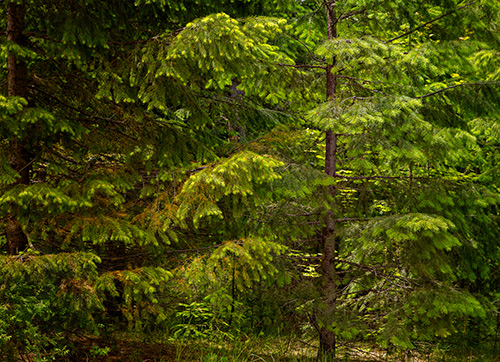
Trees
Just about anything can become interesting subject matter for a photographer. I was looking through images that I made on a family trip a while back, and came upon this one. I recall stopping to look at the river that was running swiftly over some rocks, but after stopping the car this tree caught my attention. The sun had gone behind some high clouds, softening the light, which is always a good thing. The leaves on a tree behind the pine tree here seemed to wrap around the trunk. I sat trying to figure out what it was that made the scene work and how to capture what I was feeling. I knew that the sun would soon return, so I made some quick decisions and this is what I came up with. I really like the new growth showing on the tips of the branches. The monochromatic color scheme always works for me as well. It is just a simple tree, but I like it. To me, simple is beautiful.
by tmoffett | Jul 26, 2012 | Black and White, Composition, Landscape, Photographic Philosophy, Photographic Technique
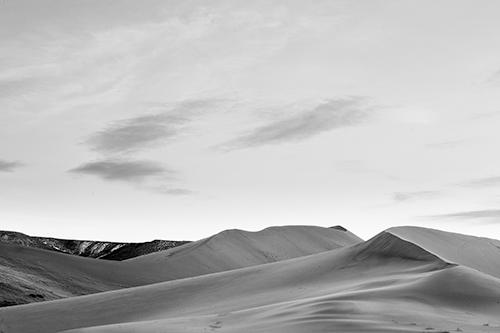
Bruneau Dunes
I was visiting with another photographer one day and we were talking about quality of light. I rise early and stay up late to photograph during the sweet light hours. This other photographer mentioned that you need the sweet light for color photography, but then switch to black and white during mid-day. I was very surprised to hear him say that and I one hundred percent disagree with him. Light quality is just that, quality. It really does not matter if you are shooting color or black and white. If you want quality light, you must work when the light is good. I have always taught my students that if you learn to shoot black and white, your color work will be much better, due to the fact that you must learn to see tones. Good tonal separation happens when the light is good. That is just another reason to photograph early and late.
The image above was made just as the sun was setting at Bruneau Dunes. The low sun is what is creating the highlight and shadows that sculpt the shape of the dunes. There is also balance between the dunes and the sky. None of this would have happened earlier in the day. For great landscape photography it is a must to photograph during the sweet light, otherwise you are just taking snapshots.
With the advent of digital photography, black and white photography is becoming a lost art. So many photographers just shoot a thousand images and then play with them on the computer to see what will look good as a monochrome image. It used to be, back in the days of film, that you would have to learn to see in black and white. We used filters to shift tones when we exposed the film, and then made additional adjustments in the development and printing stages to get the previsualized image on paper. Now we apply filters after the fact, and we get to watch the development in our “digital darkroom”… computer. It still seems so backward to me. Maybe I am just old school, but I believe that thinking before we press the shutter, like we used to do, will make us better photographers. Thinking more and shooting less is much more effective than the alternative. It will help put art back into our photographs.
by tmoffett | Jul 23, 2012 | Color, Composition, Critique, Landscape, Photographic Technique, Uncategorized
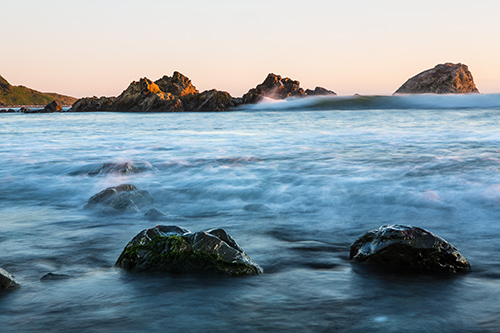
Ocean View, Crescent City, CA
I haven’t been out photographing for a few days and I am starting to get a bit antsy. I have been sitting in front of my computer getting some much needed work done, but I need to photograph. It doesn’t matter that I have a backlog of images to process and other tasks that need worked on, the need to make new images is always there. I guess that means I am a photographer. It is in my blood.
I pulled this image to post from my last trip to the coast. We were in Crescent City, California to photograph the Redwoods, but when I am close to the ocean, I will always find time to spend there. The evening I made this photograph, the sky was naked and colorless, so I really focused on the sea. One thing that I stress in my classes and workshops is to work the camera angles. Many times, especially at the ocean, I find photographers up on the beach, away from the water but shooting the water from a high angle. Not me. I like to be in the water. I try to find a lower angle to shoot from, as this will emphasize the foreground objects better. I have found that if I press my tripod down in the sand it becomes very stable. Unless a big wave slams into the tripod, it is remains quite stable in the water even at long shutter speeds. This image is a 1.3 second exposure, tripod legs buried under about 18 inches of water and waves hitting the tripod legs. The image is still tack sharp. When photographing this way you must keep an eye on the incoming waves, as occasionally a sleeper wave will come out of nowhere and you better be ready to move or risk soaking all of your gear. For this image, I actually wanted to get lower, but when I did, the incoming waves blocked the view of the rocky background too much.
One thing I really like about this image is not only the emphasis on the foreground rocks, but how the low angle also enlarges the size of the wave coming in. The wave creates a nice transition from ocean to rock in the background. I know it is hard to see in the small image here, but the water is packed with texture, detail and subtle color shifts, showing the warm light of the setting sun reflecting off of the highlights, but the deeper parts of the water remain a rich and vibrant blue. There is a lot of life in the finished print.
by tmoffett | Jul 19, 2012 | Black and White, Color, Composition, Photographic Technique
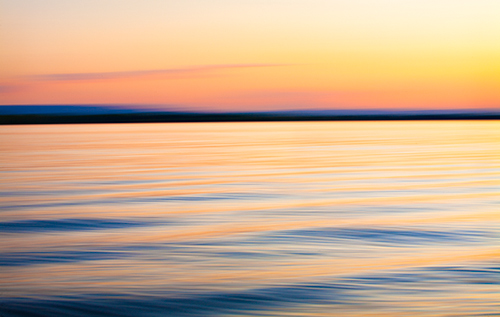
Complementary Reflections
It seems kind of strange to me to be talking about color. My photographic roots are in black and white. Before digital came into play, all of my personal work was black and white. I wouldn’t even carry color film with me. I loved what I could do with black and white. The entire process from shooting to processing to printing was fascinating to me. Expanding or compacting the tonal range of a scene and moving the tones to where I thought they should be was what I loved. I felt in complete control of the scene I was photographing. Then came digital.
The changes that digital brought along have been significant to me. I won’t go into them all now, that is for another time. The one change that I will discuss, though, is how it has affected my use of color. I still like to print in black and white, but I have added color as well to my repertoire.
Photographing in color first, and then converting the image to black and white, I began noticing how color could affect an image. I began studying the color composition of each of my photographs before converting them to black and white, and soon I began looking at the color in a scene and analyzing it before pressing the shutter. Little by little, color photographs began appearing in my portfolio. Now, it seems, that only those very special images make it to black and white.
The image above, Complementary Reflections, is one where color is everything. Without the color, the photograph would be a complete failure. The cool tones of the eastern sky reflecting in the water filled with the warm colors from the setting sun creates a feeling of excitement in the image that draws me in. When making this photograph, I got an idea to do a series of abstract images about color. Most of the photographs in the series so far I have made at the ocean, but occasionally I find just the right conditions on a lake or other body of water to photograph this way. It is fun and exciting to evolve and change. This change, to photograph in color, never would have happened for me if I had resisted the move to digital capture. It has been challenging at times, but always exciting!
This photograph also appears in my book Silent Solitude.
by tmoffett | Jun 14, 2012 | Color, Composition, Landscape
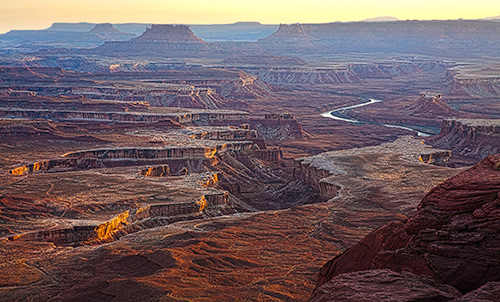
Canyonlands, Green River Overlook
I have been revisiting some images from past photo safari’s that I have taken and found this image from Canyonlands in Southern Utah. This is an area that I would very much like to visit again. The red rock canyons are very unique, and under good lighting conditions seem to glow. It is something that I don’t have here in Idaho (although we do have other features unique to us). I love, in this image, how the setting sun reflects off of the canyon walls, creating a warm glow that opens up the deep shadows deeper in the canyon. It also is full of dynamic lines zigzagging throughout with a dominant S-shaped curve in the river and the extreme depth created by the atmospheric haze. I vividly remember standing on the ledge overlooking the view, wind howling up the side of the cliff, totally in awe of the scene in front of me, wondering how I could do it any justice. I hope in some small way, I have. For me, at least, it reminds me of a very impressive time of my life. I live for these moments.
Next week I will be venturing out again on a much needed photo safari, this time to the Northern California coast. I have fallen in love with the ocean. It is almost therapeutic for me to sit and watch the waves pound the shoreline or gently lap up on a sandy beach. I could sit and watch for hours on end. Trying to create photographs that illuminate my feelings as I watch the waves in action is a challenge that, when successful, I find very rewarding.
by tmoffett | May 24, 2012 | Color, Composition, Ramblings

Sunflowers, Lake Lowell
I like a simple life. A walk on the beach. An afternoon nap. Daydreaming. A bike ride. A good book and an hour to kill. When I can slow down and enjoy life, my vision becomes clearer. I see things that otherwise I may pass by.
It is too easy to let life get complicated, and then we miss so much. When rushing from point A to point B it is difficult to focus on the journey, yet the journey is what should be important. I have to remind myself often of that fact. This simple image of a couple of sunflowers is a reminder to me to simplify. As I was on a walk out at the lake one evening, I passed by a patch of sunflowers, and these two blossoms caught my attention. I had to work to find an angle that would isolate them and simplify the composition while maintaining the feeling that they instilled in me. Much like in life, simplifying takes effort. We must work at it and strive for it. When we succeed, it is a beautiful thing.








Recent Comments